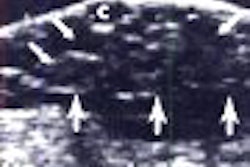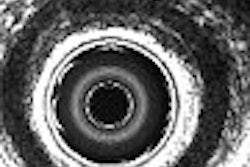Of four proposed sonographic criteria for evaluating solid thyroid nodules, a nodule shape that is taller than it is wide offers the highest positive predictive value for diagnosing cancer, according to researchers from Yonsei University in Seoul, Korea.
"The taller-than-wide shape is the best predictor of malignancy," said Dr. Yoo Jin Hong, who presented the team's results on behalf of Dr. Eun Ju Son and other Yonsei researchers at the 2006 RSNA meeting in Chicago.
In 2002, Yonsei researchers had described four findings as new ultrasound criteria for thyroid malignancy: microcalcification, irregular margin or microlobulated margin, marked hypoechogenecity, and a nodule with a taller-than-wide shape (American Journal of Roentgenology, March 2002, Vol. 178:3, pp. 687-691).
The authors of the current study sought to assess the positive predictive value (PPV) of the features described in the new sonographic criteria, and to determine the most reliable feature for predicting thyroid malignancy. Between January 2005 and November 2005, 594 nodules were studied.
Of these nodules, 19 were excluded due to an inadequate study and 41 were excluded as cystic nodules. As a result, 534 solid nodules that received fine-needle aspiration biopsy (FNAB) were included in the research project.
The patient population included 462 patients with a mean age of 51.2; all patients received an ultrasound study on a high-resolution ultrasound scanner with a 7-12 MHz transducer, Hong said. Ultrasound-guided FNAB was performed twice for each nodule using a 23-gauge needle.
Of the 534 nodules, 82% were benign and 18% were malignant. Malignant cases included 87 papillary cancer cases (93%), five follicular cancer cases (5%), and two metastatic cancer cases (2%).
The microcalcification criteria had a sensitivity of 42.6%, specificity of 85.5%, a PPV of 38.5%, and a negative predictive value (NPV) of 87.4%. The irregular or microlobulated margin criteria had sensitivity of 70.2%, specificity of 87.9%, PPV of 26.7%, and NPV of 90.2%.
Display of marked hypoechogenecity had a sensitivity of 41.5%, specificity of 58.9%, PPV of 50%, and NPV of 87.9%. As for the taller-than-wide shape, that sonographic feature had sensitivity of 50%, specificity of 92.3%, PPV of 58.5%, and NPV of 89.6%, according to the researchers.
With the exception of the irregular or microlobulated margin (p = 0.27), the other three criteria had a p value less than 0.01, suggesting these were significant findings for malignancy, Hong said.
The authors also noted that no significant statistical difference was found between two groups with nodules 1 cm or smaller or nodules larger than 1 cm.
By Erik L. Ridley
AuntMinnie.com staff writer
April 13, 2007
Related Reading
Head and neck surgeons can handle ultrasound, journal article says, January 5, 2007
Rising thyroid cancer rates in U.S. due to increased detection, May 10, 2006
Lemon candy may suck for curbing dry mouth after thyroid cancer therapy, March 2, 2005
US excels in finding cervical recurrence of thyroid cancer, July 26, 2004
Copyright © 2007 AuntMinnie.com




















